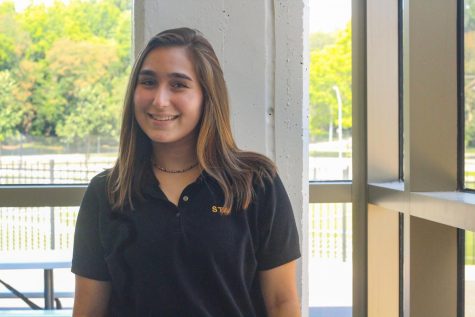Serving school spirit
Spirit Club’s efforts to facilitate a positive student culture impact enthusiasm for STA sports games and events.
October 14, 2019
Freshman Darby Beddome’s periphery fills with visions of aliens and rock stars as she prepares for her serve. An anticipating quiet falls over the stands, comprised of students, parents and community members. Attempting to focus herself, Beddome’s energy instantly spikes as she hears the eager crowd’s chant: “that’s our freshmen, that’s our freshman!” The serve is a success, another point against Notre Dame de Sion High School.
According to Beddome, audience support frequently inspires increased motivation levels for athletes like her.
“If you have more energy and your crowd is there and both teams are cheering against each other, it just makes it a better game and makes the team better,” Beddome said.
The seven-year volleyball player witnesses the implications of crowd participation in each game she plays in and watches.
“Overall, the team with more energy can win and is probably going to win,” Beddome said.
Varsity volleyball player Elise McGhie agrees with Beddome and believes this positive influence is especially vital to their case as players on a school team.
“I think that having school spirit and support gives you confidence and an extra driving force,” McGhie said. “That’s what’s so special about playing for your school versus playing for a club or competitively — you’re playing for something bigger than yourself.”
According to McGhie, playing for STA is motivating at its core.
“Having that mentality that you want to win a State championship, not just for you but for your school, pushes you harder and makes you want to work harder,” McGhie said.
Spirit Club vice president Anna Johnson has worked with her fellow officers to make facilitating this positive culture a priority for her club.
“Through [my] sophomore and junior year, it seemed like people didn’t really care about sports games, plays, musicals or any events,” Johnson said. “This year, we’re really trying to, especially for the Future Stars night that just happened, get people to hype up the games because it really helps the athletes.”
Spirit Club president Elle Schloegel believes an effective way to interest students in games is to create unique costume themes.
“This summer, we [officers] spent a day gathering costumes and taking pictures,” Schloegel said. “I think that people seeing that themes are a main part of our club and watching us dress up in costumes for no reason is a big deal for them.”
According to Schloegel, this tactic has proven successful in increasing support for athletes as well as promoting self expression.
“Some people that always go all out are inspired by the theme and feel like they can be themselves,” Schloegel said. “It’s not like a normal thing; you don’t just put on a costume every day. It’s a kind of rare experience.”
McGhie believes the increased social media presence of STA on official and student-led accounts has also contributed to student engagement.
“This year we’ve had a super good amount of support and maybe that’s somewhat to the credit of the new Instagram and Twitter accounts,” McGhie said. “I think that does help with people keeping up to date with all of the sports.”
Spirit Club member Alex Kerr began posting on the club’s Instagram after a one-year hiatus of the account to better promote game attendance.
“If I post the day before saying there’s a game tomorrow, [students] are thankful for the reminder,” Kerr said.
Johnson believes the account provides publicity for all of their club’s endeavors.
“There’s Instagram pages for the athletics department and the big STA page too, but there wasn’t really one that showed support for everything,” Johnson said. “We thought that reviving the Instagram would be a great idea because there would be a place to showcase everything.”
Spirit Club moderator Maddie Watts appreciates the unification that social media provides.
“I think social media involvement makes people feel more visible and connected so they know what’s going on and how to engage in it,” Watts said.
According to Schloegel, the increased level of school spirit, partly due to Spirit Club’s Instagram posts, has also enhanced STA community members’ experiences at games.
“During the last Sion game we were at, we started singing ‘Party in the STA’ and lots of parents got out their phones and started recording us,” Schloegel said. “I know they see so much of the at-home stress of homework and papers, but when they’re at the game seeing all of us have so much fun in costumes and singing songs, they love that.”
Watts believes this impact extends further than just parents.
“When you have little girls that come to the game and they see us cheering each other on and they see everyone here as friends and that everyone belongs and everyone is working toward a common goal, I think that moves them a lot,” Watts said.
Spirit Club will further promote inclusivity this year by including underclassmen in pep rallies rather than primarily featuring seniors as previous Spirit Club officers have, according to Johnson.
“For the winter pep rally, that video is going to be mostly freshmen and sophomores because in past years it’s been awkward for them,” Johnson said. “I feel like it was awkward for mine — you’re in a new club with people you don’t really know and you’re supposed to be pumping up the school but you aren’t even in the videos.”
As a former STA student, Watts has witnessed this concept firsthand.
“When you just have juniors and seniors being in front of everything, I know sometimes those freshmen and sophomores don’t feel as included,” Watts said. “But when you have those freshmen and sophomores in Spirit Club pep rally videos, they can relate to that.”
According to Watts and the Spirit Club officers, the club’s ultimate goal is to create a supportive culture for all STA students, faculty and community members through the promotion of enthusiasm for the school.
“In a sense, I love that seniors take ownership and are proud of their school but at the same time when you have those freshmen and sophomores engaged, instead of having 150 girls engaged and feeling like they belong, you have 620,” Watts said.




